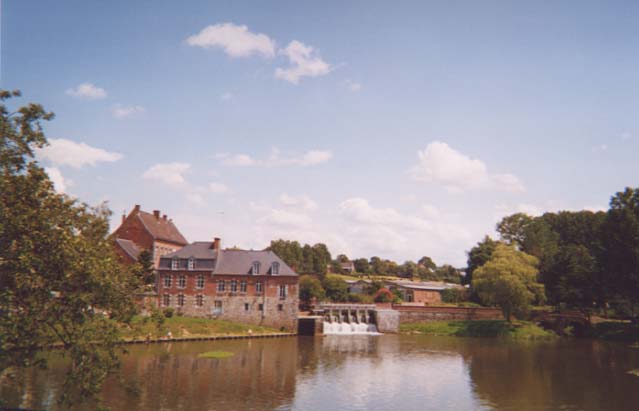I) Prehistory,
Antiquity and early Middle-Ages (till 843)
Although Landrecies itself was founded in the
7th century AD, we are pretty sure that the site of the town was occupied as
early as the prehistoric period. Indeed, quite a lot of primitive tools have
been recovered and they show that Landrecies was then used as a major transit
place for nomadic tribes, and as a living place for local sedentary tribes.
 (Flint tools, Special coll.)
(Flint tools, Special coll.)
On the above image, you can see some of the
flint tools that have been discovered in Landrecies. Those at the bottom are
quite big and could have been used as percussion tools, picks, grattoirs or
planes. On the contrary, those at the top are much thinner and probably had
different functions, like arrowheads.

Actually, until the the Roman invasion in 50 BC
very little is known about Landrecies and this entire northern part of what is now
France. The only thing that can be said is that the area was settled around the
3rd century BC by Belgian tribes, which were of Celtic origin. One of those
tribes in particuliar, the "Nervians", took control of the Landrecian territory.
By the way, that's why there is now a "Nervian Street" in the contemporary town.
During the Roman period (50 BC down to 406 AD) a
very rich rural civilization develops in northern Gaul (i.e the ancient name of
France), relying mainly upon wheat and sheep. This is the first time in history
we can assert that the territory of Landrecies was occupied by a permanent and
even prosperous population.

The recent discovery of Gallo-Roman archeological items,
and especially of a lot of
old coins is a good reason to think so. They were fished out of the Sambre river, not far from the
contemporary bridge of the town.

Although it must have been an inhabited place, Landrecies was certainly far from being an important town : actually the
greatest Roman town in northern Gaul was then Bagacum (today Bavay), some 15
miles north, on the other side of the Mormal forest.
From the 3rd century AD, northern Gaul
experienced increasing Barbarian raids, especially by Frankish tribes. Most of
the time, these raids made the rich northern cities fall prey to looting and
destruction. Although we don't have any direct source of information on that
issue, Landrecies was probably no exception. The final disaster came in 406 :
Barbarians invaded Gaul from their native German lands and thus ended the "pax
romana". The little Gallo-Roman community occupying the Landrecian territory was
razed to the ground.

Then came the so-called French Merovingian era,
during which what happened in northern France is quite blurred . The area was
dominated by a series of insignificant local kings, without any reliable urban
center. From the 6th century AD, however, a new urbanization was under way
thanks to the spread of Christianity : dynamic bishops and monks promoted the
development of new small urban centers. As regards to Landrecies, the rebirth of
the town was greatly eased by the monks of the Maroilles abbey, 4 miles east.
Indeed, the Maroillan monks engaged in a widespread land clearing, creating a
lot of potentially farmable new lands. This favored the emergence of a new
village around the 7th century AD, on the left bank of the Sambre river.
Landrecies was born !

According to some historians, Landrecies was
actually named Landrecies at that time, and maybe thanks to a man called Landri. Landri was the prime minister of a local Merovingian king who was called Chilpéric
I. This king ruled over a large part of northern France. Thus, according to the
legend, Landri would have founded the town of "Landerictacus" (i.e "Landri's
estate") somewhere between 580 and 590 AD.
However, this story remains historically
doubtful, and strongly sounds like a myth. Moreover, there would be no pride for
Landrecies to have been founded by such a man, because Landri was a very shady
character. In 584, he allegedly plotted with Chilperic's own wife, Fredegonde,
to murder the king and replace him. In other words, Landrecians are not eager to
claim a traitor and a murderer as their ancestor !!
In the year 800 the great empire of
Charlemagne emerged. Western Europe was then unified under the rule of a single man. But
this golden age was short-lived : in 843, the heirs of Charlemagne signed the
famous Verdun Treaty to share between them this huge territory. The empire was
divided into three parts, and this was a crucial event for Landrecies : indeed,
the border between the westernmost kingdom ("Francia occidentalis", soon to
become France) and the middle one was arbitrarily defined as the Escaut river,
some 20 miles west of Landrecies. Thus, it meant that Landrecies wasn't in the
French part, and that it was put under the domination of the middle kingdom, a
strongly German one, featuring such towns as Koln or Aachen !

Was Landrecies about to become a German land ?
Next
: Landrecies, a German land ?
(843 - 1482)
 (Flint tools, Special coll.)
(Flint tools, Special coll.) (Flint tools, Special coll.)
(Flint tools, Special coll.)




